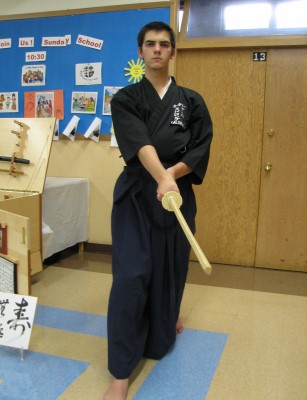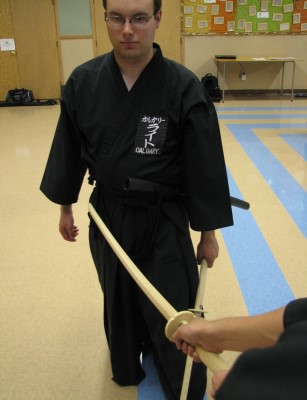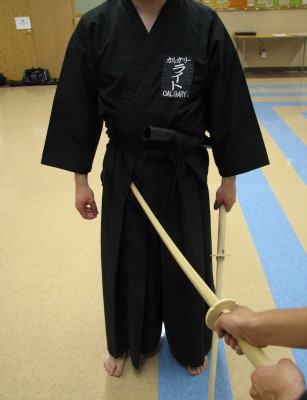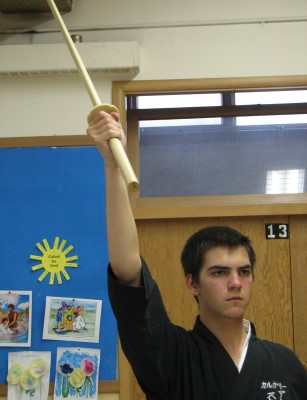copyright © 2009 Chris Gilham, all
rights reserved
See Riai and Technique: The Story and the Performance Kim Taylor for another important aspect of the story essential to this form.
Our main point is essential to the finish of this form: Kirioroshi is a kesa cut and therefore the tip must finish to the left of your centre (as in #5 Kesa Giri) , in order to complete the cut along the kesa line. See the photos below of Joe, doing this accurately and David, playing the role of teki.


If the cut finishes with the tip in line with centre of Iaidoka, then it is not a complete kesa cut: it does not move completely through teki, as one can see in the photos below of Joe doing this cut inaccurately, and David remaining skewered as teki.


Easy enough - right?
We experimented with this quite a bit and we've decided it's a fairly precise movement, actually. This cut requires the hips to be in the 'right place' or 'groove' when executing the cut. If the hips are in the 'right groove', the rest of the body should also find its proper place.
What is the 'right groove'?
Hips are just off centre to the original line which means they are acutely forward to the original line. See Joe's feet in comparison to the initial attack line: this is how forward he must be in order for the kesa cut to execute properly through teki (who is still moving through the original line). Notice in the picture that Joe is well off the initial attacking line? Joe is actually right next to a separate parallel line about one foot width away from the initial attacking line. He gets here by moving into this position properly, another important piece of this movement not covered here in this article.
If Joe's hips are further toward, or pointing at, the original attacking line, his cut will be something completely different from kesa and in worst cases, he'll only clip teki or miss him altogether.
Therefore, keep the hips quite forward to the line (slightly off parallel to the line) and finish the cut with the tip to the left of your centre. It's best to try this with a partner and bokuto - in super slow motion!


Backing up the bus a bit here, Joe also has to start this cut in the right place as he is here, above: About one fist width away from his right ear, arm straight, tip well up and hasuji in the direction of the kesa cut. Kim Taylor sensei's pointing of the tip almost vertically, after receiving teki's cut, helps to keep the cutting arm from collapsing over the head as the cut initiates.
So, a few things need to come together here to make the riai of Uke Nagashi come to life!
With thanks to Yamamoto and Taylor sensei for these important points during their recent visits.
See Riai and Technique: The Story and the Performance Kim Taylor for another important aspect of the story essential to this form.
Our main point is essential to the finish of this form: Kirioroshi is a kesa cut and therefore the tip must finish to the left of your centre (as in #5 Kesa Giri) , in order to complete the cut along the kesa line. See the photos below of Joe, doing this accurately and David, playing the role of teki.


If the cut finishes with the tip in line with centre of Iaidoka, then it is not a complete kesa cut: it does not move completely through teki, as one can see in the photos below of Joe doing this cut inaccurately, and David remaining skewered as teki.


Easy enough - right?
We experimented with this quite a bit and we've decided it's a fairly precise movement, actually. This cut requires the hips to be in the 'right place' or 'groove' when executing the cut. If the hips are in the 'right groove', the rest of the body should also find its proper place.
What is the 'right groove'?
Hips are just off centre to the original line which means they are acutely forward to the original line. See Joe's feet in comparison to the initial attack line: this is how forward he must be in order for the kesa cut to execute properly through teki (who is still moving through the original line). Notice in the picture that Joe is well off the initial attacking line? Joe is actually right next to a separate parallel line about one foot width away from the initial attacking line. He gets here by moving into this position properly, another important piece of this movement not covered here in this article.
If Joe's hips are further toward, or pointing at, the original attacking line, his cut will be something completely different from kesa and in worst cases, he'll only clip teki or miss him altogether.
Therefore, keep the hips quite forward to the line (slightly off parallel to the line) and finish the cut with the tip to the left of your centre. It's best to try this with a partner and bokuto - in super slow motion!


Backing up the bus a bit here, Joe also has to start this cut in the right place as he is here, above: About one fist width away from his right ear, arm straight, tip well up and hasuji in the direction of the kesa cut. Kim Taylor sensei's pointing of the tip almost vertically, after receiving teki's cut, helps to keep the cutting arm from collapsing over the head as the cut initiates.
So, a few things need to come together here to make the riai of Uke Nagashi come to life!
With thanks to Yamamoto and Taylor sensei for these important points during their recent visits.